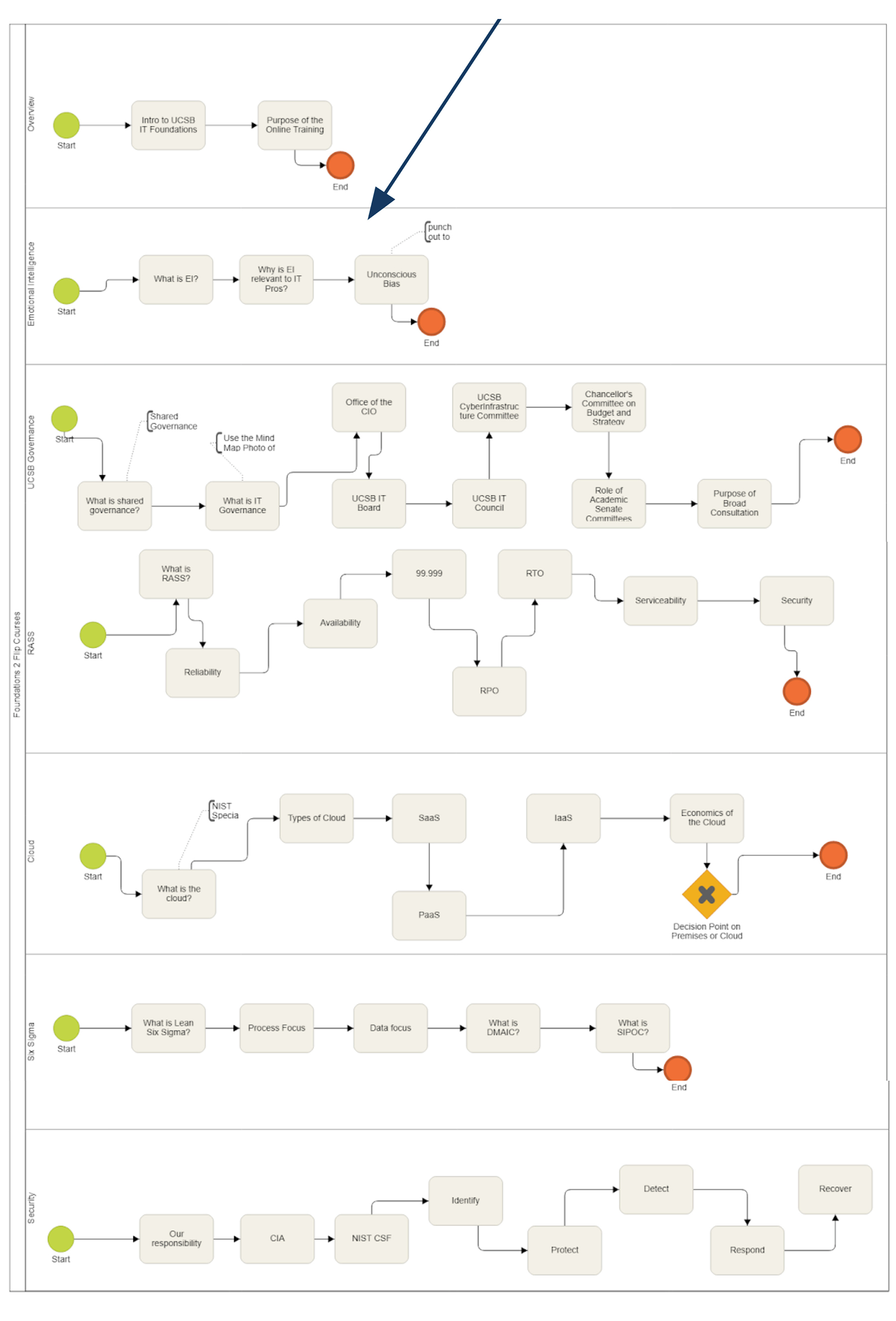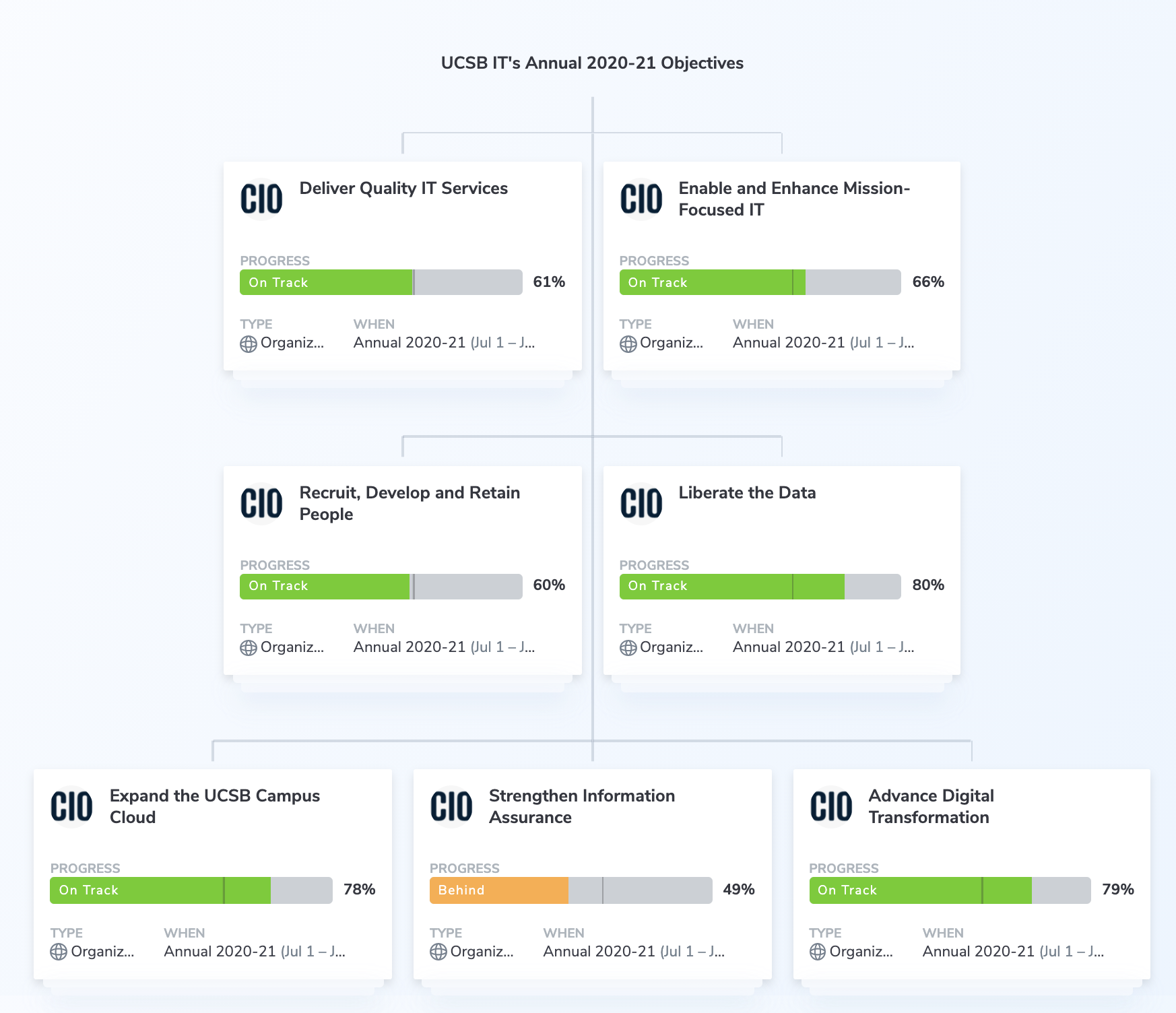Mission-Focused IT
The purpose of UC Santa Barbara Information Technology is to support an environment at UCSB that fosters its teaching, learning, research, and public service mission. The Strategic Plan aims to transform the campus IT community toward activities that directly support the university's mission.
Considering the cost of education and our desire to keep indirect costs as low as possible, how can we provide a rich IT services portfolio while maintaining an appropriate, balanced level of IT expenditure and service quality as good or better than what we've come to expect? Most expense centers around the labor force and associated indirect costs such as electricity and commercial real estate occupancy. What if we could change the fundamental ways in which UC IT enables the mission?
As demonstrated by the two donut charts below, the IT staffing profile will evolve over time to support the campus mission.
7 Strategic Visions
Each strategic vision includes key priorities that will help the campus achieve the vision over time. The following sections describe them and the key priorities that will ensure that the vision is realized.
![]()
Vision 1
Deliver Quality Services
Delivering Quality Services — or as Executive Vice Chancellor David Marshall says, “Trains run on time” — assures that the IT services necessary to operate campus smoothly are understood, managed, available, reliable, supported, and have lifecycle plans that guarantee continued support of campus needs.
Read the full details and key priorities about Vision 1: Deliver Quality Services.
![]()
Vision 2
Enable and Enhance Mission-Focused IT
Enabling and Enhancing Mission-Focused IT lays the foundation of an IT ecosystem that provides UCSB with cost-effective, responsive, secure, and resilient IT services that enable our missions of instruction, research, and public service.
Read the full details and key priorities of Vision 2: Enable and Enhance Mission-Focused IT.
![]()
Vision 3
Recruit, Develop, and Retain Our Workforce
People who will fulfill the visions represent a critical component of the UCSB IT Strategy. Success requires innovative approaches to recruit new talent, helping people expand their skill sets to include the new technologies that will drive the campus, and leveraging opportunities to retain talented, dedicated people. Key Priorities support a labor force that wants to spend its career at UCSB, continually acquires new knowledge relevant to mission attainment, and primarily focuses on enabling student success and the discovery processes of our research community.
Read the full details and key priorities of Vision 3: Recruit, Develop, and Retain Our Workforce.
![]()
Vision 4
Liberate the Data
Data is an institutional asset. Historically, data has been held in silos at UCSB, slowing decision making and leading to inefficient solutions based on insufficient data. Liberating the data provides decision-makers with ready access to the right data at the right time in the right context.
Read the full details and key priorities of Vision 4: Liberate the Data.
![]()
Vision 5
Expand the UCSB Campus Cloud
The value of floor space on the campus continues to rise as cloud computing cost competes with on-premise computing. Soon, an inversion point will occur where on-premise computing — combined with its overhead costs (space, cooling, electricity, and spare parts) — becomes more expensive than cloud architectures. Building cloud expertise and culture positions the campus to leverage cloud technologies while controlling infrastructure costs.
Read the full details and key priorities of Vision 5: Expand the UCSB Campus Cloud.
![]()
Vision 6
Strengthen Information Assurance
Information Assurance addresses the need to protect campus information assets. Growing and emerging threats such as hacktivism, cyberwar, and attacks on data integrity risk campus information assets and are amplified by environmental changes such as the Internet of Things (IoT), Bring Your Own Device (BYOD), and increasing systems complexity. Information Assurance Defense in Depth follows the NIST Cybersecurity Framework of Identify, Protect, Detect, Respond, and Recover. Enhancements to current technologies and new emerging technologies and trends will secure campus information assets.
Read the full details and key priorities of Vision 6: Strengthen Information Assurance.
![]()
Vision 7
Advance Digital Transformation
Digital Transformation — the process by which inefficient processes are morphed into efficient, effective processes — combines many of the other strategic visions to provide the campus community with tangible work or risk savings. Manual, wet-signature, paper-based business processes will transform into a paperless, authoritative, and legal digital signature infrastructure.
Read the full details and key priorities of Vision 7: Advance Digital Transformation.
Aligning Visions with Objectives & Key Results
The Office of the Chief Information Officer (OCIO) has adopted the Objectives and Key Results (OKR) approach to align, track, and visualize the progress toward meeting IT Strategic Visions.
The UCSB IT OKR aligns the IT Strategic Visions with objectives and Key Priorities with key results. The OKR framework defines an objective as a goal. Key results are actions that help achieve the goal. To accomplish our OKRs, we must not only state a strategic vision, but we must also see the progress.
For example, In the first strategic vision, Deliver Quality Services is the goal or objective to be achieved, while Trains Run on Time is an action or key result that helps meet that goal.
The CIO “owns” the organization-level objectives. The key results that help achieve each objective are allocated to the appropriate IT leaders, who then track and report progress toward completing the key results each week (see image to the right).
UCSB IT's Objectives and Key Results (OKRs) as of February 8, 2021. The image above links to a dynamic graphic that shows the Strategic Visions and associated priorities.
As the campus technological foundation has begun to mature we are now able to turn our attention to the ways in which IT supports the mission of the university more directly — toward Mission-Focused IT. The Council of Australian University Directors of Information Technology (CAUDIT) provides a framework to help structure conversations and activities at UCSB that lead to Mission-Focused IT. View the full CAUDIT framework. Figures 2a - 2c below, represent a series of views of the CAUDIT Mission-Focused IT framework and help illustrate how the framework aids Mission-Focused IT.
Figure 2a: CAUDIT Mission-Focused IT Framework
Figure 2b: Many CAUDIT capabilities make up the university


Figure 2c: CAUDIT capabilities have many processes
